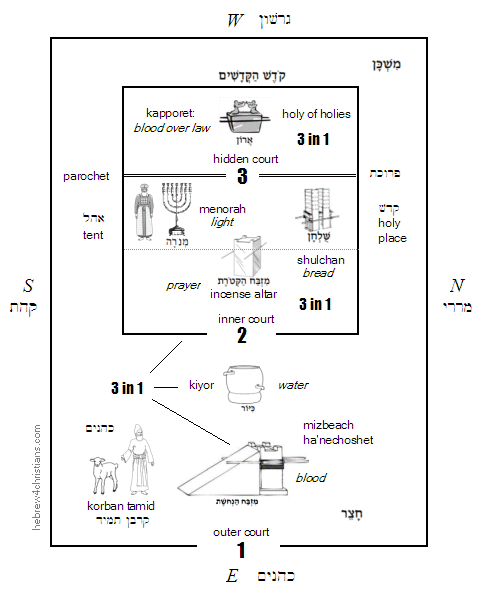|
|
|||||||||||||||||||||
 |
|||||||||||||||||||||
 |
|||||||||||||||||||||
|
|
||||||||||||||||||||||||||||
|
The Torah portion for this week is called Terumah (תְּרוּמָה), a word that means "contribution," "gift," or "freewill offering." It begins with the LORD asking for gifts "from every man whose heart moves him" to provide materials for the Mishkan Kodesh (Holy Tabernacle), a tent-like structure that would symbolize His Presence among the Israelites during their sojourn to the land of Canaan. Gold, silver, brass, red and purple yarns, fine linens, oils, spices, precious stones, etc., all were needed. No gift was considered too small, and whoever felt prompted by the LORD to give did so freely, without compulsion. God's house is always built by love freely given....
Since "the soul that sins shall die" (Ezek. 18:4) and "the life is in the blood" (Lev. 17:11), a sacrificial animal's blood sprinkled upon the Kapporet symbolically represented the life of the people who were condemned to die, and this provided a means by which God could extend His forgiveness while remaining entirely holy and just. The substitutionary shedding of blood, the "life-for-life" principle, is essential to the true "at-one-ment" with the LORD God, and the blood rituals all prefigure the greater atoning sacrifice of Yeshua on the cross at Moriah. The passion of Yeshua, in other words, is the ultimate High Priestly work of presenting blood upon the Heavenly Kapporet of God.
It is vital to recall that the detailed instructions for constructing the Mishkan were "according to the pattern (תַּבְנִית) given" to Moses at Sinai (Exod. 25:9, Heb. 8:5). In other words, the outer court (חָצֵר), the Bronze Altar for sacrifices (מִזְבֵּחַ הַנְחשֶׁת), the vessels, the inner tent with its furnishings such as the Table of the Bread of Presence (הַשֻּׁלְחָן לֶחֶם פָּנִים), the golden Menorah (מְנוֹרָה), the altar of incense (מִזְבַּח הַקְּטרֶת), and the innermost Holy of Holies (קדֶשׁ הַקֳּדָשִׁים) with the Ark of the Covenant were first shown to Moses before they were created. They were copies or "shadows" that were intended to prefigure the eternal reality of the Heavenly Tabernacle itself (Heb. 8:5, 10:1).
Among other things this lends credence to the idea of "Oral Torah," that is, that Moses was given additional revelation at Sinai that was not included in the written Torah, and this also explains how Moses foreknew that the Messiah would die for the sins of Israel (see John 5:46). After all, the God who spoke to Moses out of the Burning Bush, "the Voice of the Living God speaking from the midst of the fire" (Deut. 5:26), and the Word spoken from between the faces of the cherubim, was none other than YHVH (יהוה) come in the flesh. According to Midrash, the purpose of the Kapporet was to protect man from the judgment of God as represented by the judging angels, the cherubim. These angels are God's own messengers who must report the truth and cannot deviate from that truth. However, there is a deeper truth than the "mechanical" reporting of facts (i.e., reports about our sins and guilt), and that truth centers on sacrificial love and mercy. The sacrificial blood sprinkled on the Kapporet - representing the innocent taking the place of the guilty - "sidesteps" the issue by removing the curse of the Law from the guilty (cp. Gal. 3:13). This is the "deeper magic" of the sacrifice upon the Stone Table, as C.S. Lewis portrays it in the Chronicles of Narnia. The Kapporet therefore foreshadows the cross of Yeshua, and His shed blood is the means whereby a holy God can righteously forgive our sin. Just as the sins of the nation were atoned for by the sprinkling of the blood on the Kapporet, so the shedding of Yeshua's blood atones for the sins of the entire world. עָזְרֵנוּ אֱלהֵי יִשְׁעֵנוּ ohz-rei'-noo · e-loh-hey · yeesh-ei'-noo "Help us, O God of our salvation,
|
|
Hebrew for Christians |
|||||
|
|||||







